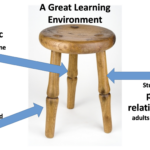Are you a teacher struggling to keep your students engaged? You’re not alone. A team of teachers at Sandown North Elementary School faced similar challenges, witnessing a decline in student engagement and an uptick in students that were dysregulated. Instead
When my district first adopted a math program I had mixed feelings. On the one hand, I was relieved. Look a this—all of my math lessons are planned for the entire year! Just imagine the time I’ll save. I won’t
Kathy Collins and I were co-teaching a summer workshop for teachers on how to teach reading effectively. We were sharing about different kinds of direct instruction—various ways we can teach students the skills, strategies, and mindsets they need to be
A great learning environment is like a three-legged stool. Ruth Charney first introduced this concept to me years ago. It’s an important idea to keep in mind all year long, but it’s crucial during the first weeks of school.
The
I know many educators bemoan retakes. It is often seen as giving kids too many chances, not holding them accountable, and generally “lowering the bar.” I’ve heard the warning “There are no retakes in real life!” too many times to
What Are We Doing Today in Physical Education?
“What are we doing today?” is the most frequently asked question by my middle school students while entering the gym to get ready for class. After my response, students will usually either
A friend and colleague of mine, Andy Dousis, once told me that every lesson has three moments: a golden one, a silver one, and a leaden one. Whatever you say in the first 60 seconds of the lesson is the
Square pegs and round holes. This phrase plays over and over in my head each time I try to assign a letter grade to my students at the end of a marking period. My students’ learning is so complex, and
Walk through most schools, and you’ll see messages like the ones above, posted in classrooms and in hallways. We often encourage kids, as they’re about to work to “try your best” or “put in max effort.” One year in
“How’d it go?” On the surface, it is such a basic question. I’ve been asked that question plenty of times in my life. After a sports game, doctor’s appointment, or school meeting, not to mention that nerve-wracking best man’s speech
In the final episode of Season I of Ted Lasso, players are somber and nervous heading into a do-or-die match against a superior team. Ted decides they all need to try something new, so he invites the players to name
In this vlog post, published through Eduplanet21, I share a story about a student who seemed motivated but wasn’t really self-motivated. She was always seeking my approval: “Is this okay? Is it good enough?” I tell about how I helped
Don’t look now, but the end of the school year isn’t far away. Of course, we know how important the first weeks of school are, but what about the last weeks of school? Surely, this is just as important a
As schools welcome more and more students back through their doors, we’re all trying to figure out the best way to do so. It seems as though there are two wildly different needs we must address. As I talk with
As educators, we all want our students to be motivated. Teachers and schools often pour immense amounts of energy into trying to motivate students, yet often it seems like the more we try, the less kids care. What’s going on?
Teacher language can be a great focus for a New Year’s resolution. After all, we all use language with students, and we all surely have some habits that could use some refinement. Often, some of our language habits don’t line
You want at-home learning to feel purposeful and engaging for students, but you don’t want to further overwhelm yourself with work. What if there was a way to both boost student engagement and reduce the daily assigning, correcting, and keeping
Games can boost engagement and learning for students while also reducing teacher workload--a win-win!
What if there was a learning strategy that boosted student engagement, had many (many!) academic benefits for students, and reduced teacher planning and correcting/grading time? Great news! There is–and it’s a tried and true strategy you have probably been using
It might be the understatement of the summer that teachers, students, parents, and administrators are anxious about the upcoming school year.
In addition to the priorities of health, safety, and equity of access to education in this COVID-19 period, distance
I was delighted to join a group of deep thinkers for an in-depth panel discussion about leaner-centered education. Hosted by Julie Mountcastle of the Slate School, this conversation is rich and engaging. You’ll hear about the importance of cherishing children’s
A Conversation with Mike Anderson, Little Things First
This is part 3 of a four-part series on how to support educators in the midst of the coronavirus pandemic.
In this conversation with the Little Things First podcast hosts, Tracy
A high school math teacher is recording short lessons on his phone in his basement, using a dry erase board and marker as he explains new math concepts. He posts the videos and then offers one-on-one and small group coaching
This article appeared in the Responsive Classroom Newsletter: November 2015 (https://www.responsiveclassroom.org/article/our-classroom-walls)
During the school day we spend most of our time in our classroom and so do twenty to thirty students (give or take a few!). Many of us feel
This article was published in the October 2015 edition of Educational Leadership (Emotionally Healthy Kids) as an online-only article. It explores how social and emotional skills are woven throughout the Common Core State Standards and what that means for good













